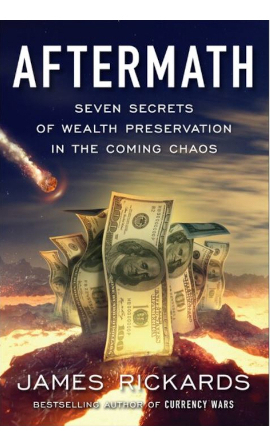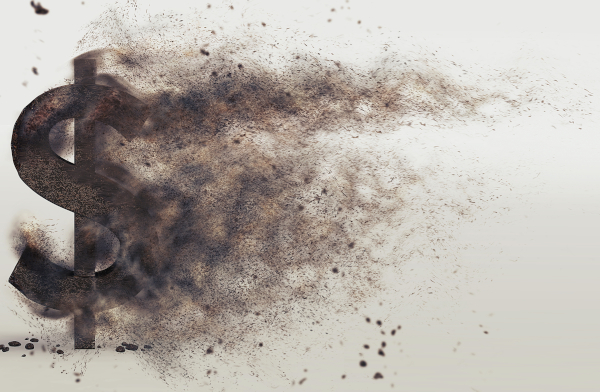
Reflections on Vancouver, British Columbia and other topics, related or not
The end is still nigh
So James Rickards found time to write
another doomsday survival guide
Greg Klein | August 21, 2019
John wrote just one Book of the Apocalypse but James Rickards has finished six so far. His most recent, Aftermath: Seven Secrets of Wealth Preservation in the Coming Chaos, offers warning and advice for the economic end times that he considers imminent. Exactly how and when that’ll happen, he doesn’t say. But this book continues his exposé of the world’s monetary system: “the real system as distinct from the one elites would have you believe exists.”
What Aftermath provides in addition to Rickards’ trademark pitch for gold are some very general tips on investment and asset allocation—so general, however, that they hardly merit a book. This volume’s strength comes in its essays, discussions and digressions on a variety of (usually related) topics.
Among the most important is public debt, primarily that of the U.S. Long unsustainable, the burden groans under a 300% increase over 20 years, currently fuelled by Donald Trump’s revival of trillion-dollar deficits. He gets away with it, though: “Entitlements and defense both get to gorge at the trough, so there’s no dissension in D.C. The only loser is the country.”
Among the less-acknowledged causes of American debt are student loans, “now more than 50 percent larger than the junk mortgage pile in the last financial crisis” and growing. Also growing are the default rates, already more than three times that of mortgages at the height of the 2007-to-2008 crisis. Of course Canadian data would be interesting to know, at least for the non-natives and non-Quebecois who pay for post-secondary education.

Debt hardly distinguishes the U.S. from other countries, and the entire world remains at risk from contagious sovereign defaults in emerging countries. Rickards’ at-risk list might surprise some readers.
“China is a Ponzi like Madoff. China has trillions of dollars in external dollar-denominated debt, wealth management products, bank loans, intercompany loans, and other financially engineered arrangements that can never be repaid. If everyone with a claim on China wanted her money back, China couldn’t come close to satisfying even a small portion of those seeking liquidity.
…. Apart from borrowed money, wasted infrastructure investment, and fictitious accounting, there is no Chinese economic growth miracle.
While the U.S. denominates its debt in U.S.-printable U.S. dollars, money-creation won’t work forever. The only thing supporting fiat currency is confidence, and that can’t last, Rickards argues. History, psychology and common sense demonstrate that “confidence in money is fragile, easily lost, and impossible to regain.”
Spreading to all reserve currencies, “this loss of confidence will be exacerbated by malicious efforts on the part of Russia, China, Turkey, Iran, and others to abandon dollars entirely and to bypass the U.S.-dollar payments system.”
Contagion demonstrates one danger of interconnected systems, but exceedingly complex technology and financial instruments intensify the peril. Flash crashes only hint at the possibilities, Rickards suggests.
“Markets now confront a lethal brew of passivity, product proliferation, automation, and hypersynchronous behavioral responses. This accumulation of risk factors is entirely new, and outside the experience of any trader or quant.”
Getting back to currencies, the author presents intriguing evidence that a gold standard is actually in place. Using research from D.H. Bauer, Rickards says that special drawing rights, the International Monetary Fund reserve asset that’s speculated to replace the U.S. dollar as the world currency, have been pegged to gold. Bauer’s data shows yellow metal hovering around SDR900, fluctuating no more than SDR50 in either direction.
Rickards blames China. “Even if the peg is nonsustainable in the long run, it’s a clear short-run signal that China is betting on the SDR and gold, not the yuan or the dollar. An important pillar of a global monetary reset seems already in place.”
Ever excursive, Rickards offers an interesting perspective on the highly controversial Russian purchase of a Canadian mining company of strategic importance to the U.S. He served on a CIA advisory board as manoeuvres by Uranium One honchos Ian Telfer and Frank Giustra (a Vancouver stock-hustler) with their buddies Bill and Hillary Clinton led to the company’s 2010 takeover by Russia’s state-owned Rosatom. “It’s as if the deal were being handled inside the intelligence community on a special track, precisely to avoid the analysis our group was formed to provide.”
Another digression looks at the disturbing prevalence of surveillance, data mining and choice architecture to monitor and manipulate citizens. “Neofascist” China plans 600 million surveillance cameras, digital facial and gait recognition software and internet monitoring to reward its people for good deeds or penalize them for offences ranging from smoking in public to tweeting verboten thoughts.
He also criticizes some alternative end time strategies. “Most plans for catastrophe will fall apart in the first five minutes of being needed.” Survivalists holed up in bunkers will face “pop-up militias,” he warns. The ultra-rich, with plans to flee to their luxurious New Zealand estates, haven’t considered how they’ll get to the airport, how they’ll refuel their private planes en route, whether they’ll get past NZ military on arrival, or how they’ll ensure the loyalty of their private security guards. The catastrophe will be worse than they imagine.
Even so, too many of his digressions are unnecessary, such as his tedious account of being locked out of his car, an unnecessarily long rebuttal of behavioural psychology and the rather weird discussion of finite size involving King Kong, Godzilla, skyscrapers and whales.
“Investors should not focus on the cause of the collapse (it’s a long list and the timing is uncertain),” he notes. Certainly the book’s rambling nature belies any sense of urgency. He even hopes to finish another volume before the apocalypse appears.
That would be his seventh on the subject since 2012.
